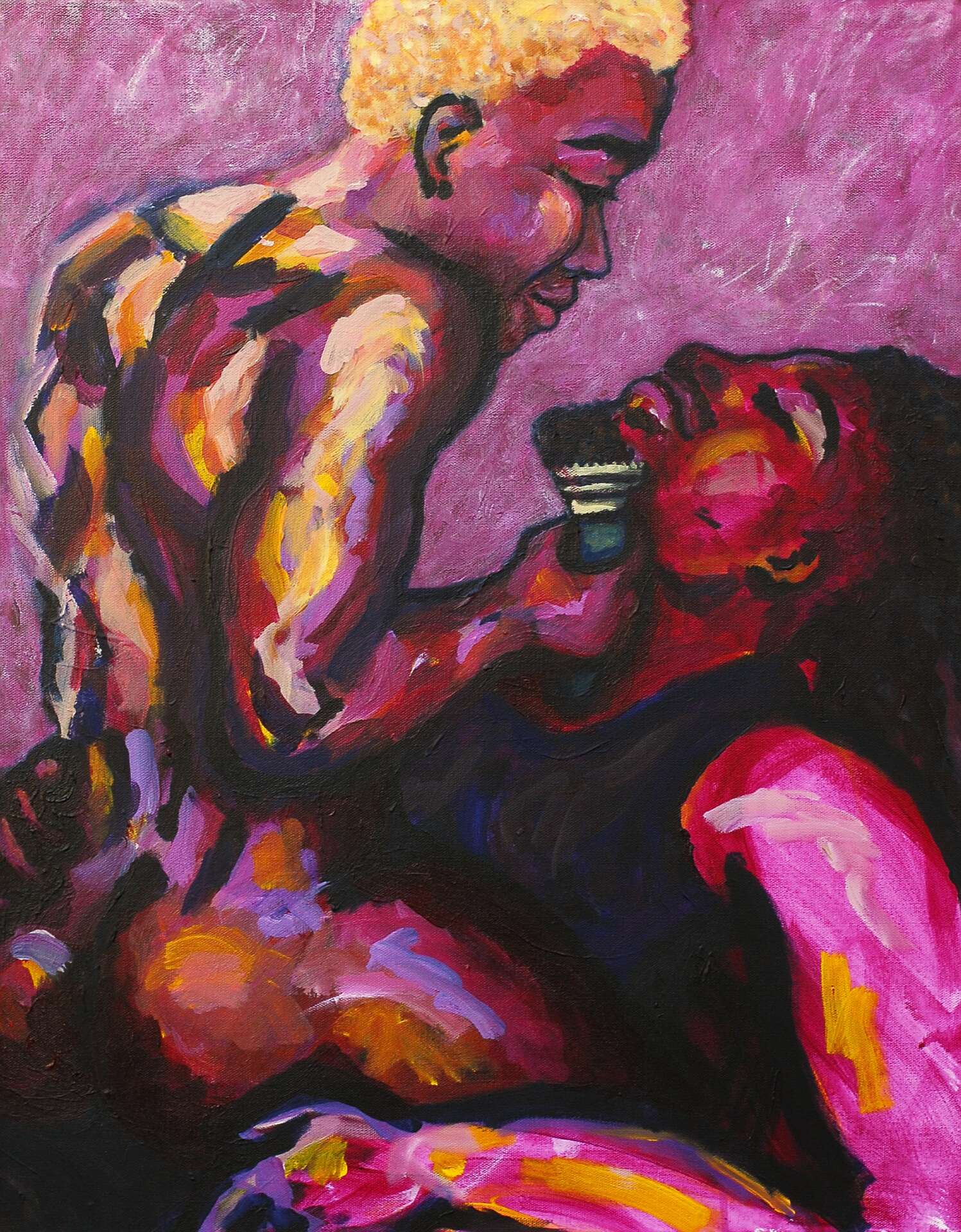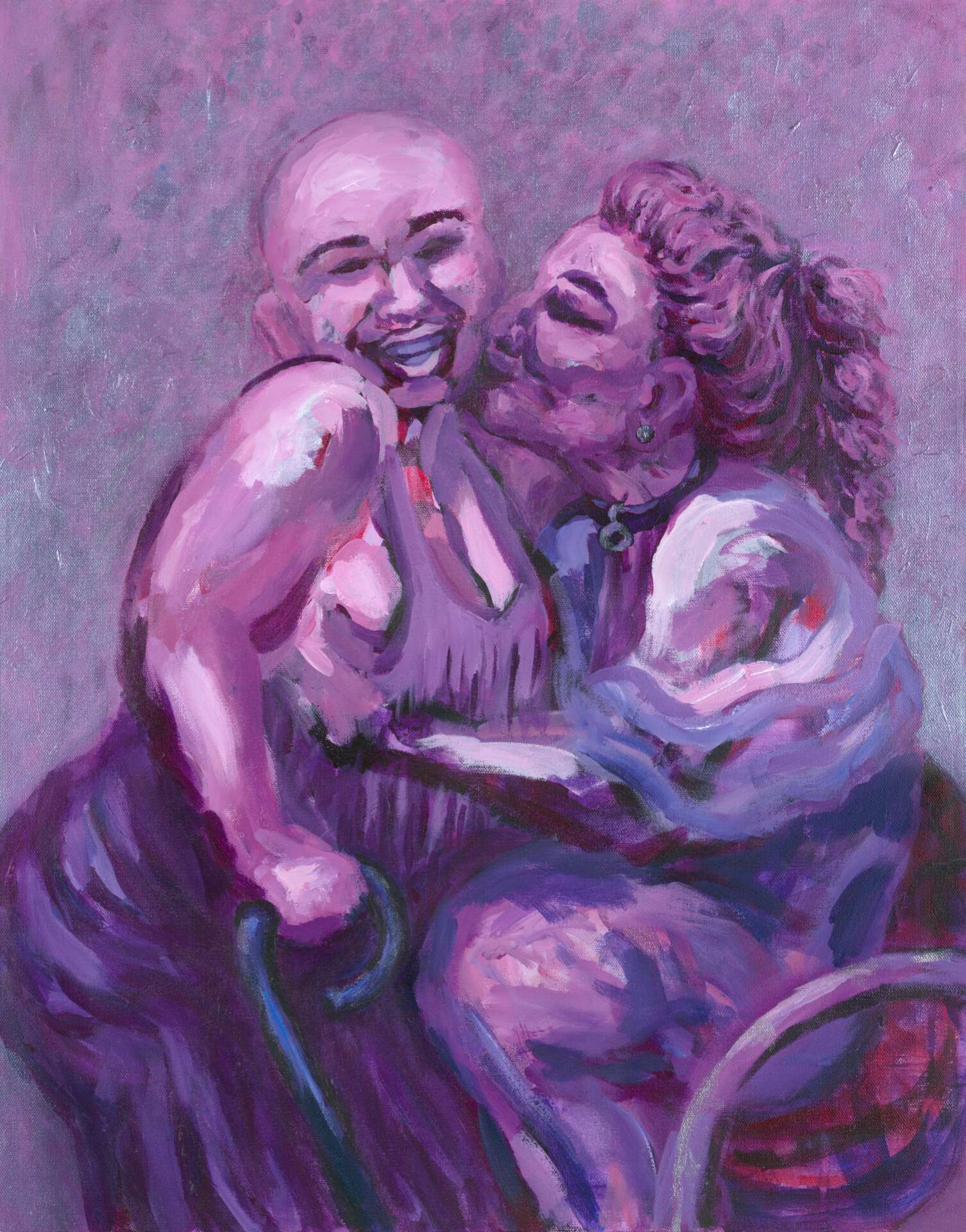We recently connected with Rachel Ungerer and have shared our conversation below.
Rachel, appreciate you joining us today. So let’s jump to your mission – what’s the backstory behind how you developed the mission that drives your brand?
My paintings are a celebration of disabled queer sexuality and mutual care. As a disabled queer person myself, I hope to rewrite the narrative about my community and challenge discriminatory views.
Honestly, my colorful art was born from anger. I am outraged by the harm systemic oppression has caused me and my community. As someone who became permanently disabled in my early 20s, I have a visceral understanding of how much worse disabled people are treated. I have been denied health care from entire departments at medical facilities, due to disability. I endured procedures that caused lasting bodily harm, because doctors did not believe my account of my pain. When others misunderstand disability it results in discrimination in employment and housing. Even interpersonal relationships can be challenged by implicit bias against disabled people.
I make art to disrupt misconceptions and encourage the audience to relate to the disabled people in my paintings. My work celebrates mutual care and community to challenge the way disabled people are perceived as a burden. My paintings depict people with visible and invisible disabilities caring for each other or even their able bodied partners. Disabled people, in community, are shown as each other’s accessibility. My work explores mutual care and kink as two sides of the same coin.
The unedited sexuality in my work confronts the way disabled people are desexualized and infantilized. My work is a celebration of desirable disabled queer sexuality. I explore the way that kink can reveal unique avenues of pleasure tailored to our bodies and through kink our mutual care becomes part of sensual play. Consensual power dynamics in kink allow us to reclaim the power that society would strip away by choosing who is worthy of it. Without the stigma of societal expectations, disabled queer people are not othered for being different. We are beautiful and sensual as we are, access needs and all.
![]()
![]()
Rachel, before we move on to more of these sorts of questions, can you take some time to bring our readers up to speed on you and what you do?
I am a local Bay Area queer disabled painter who uses my art and activism to impact social change. After developing a chronic pain condition limiting the use of both hands, I have worked as a professional artist, curator, and public speaker discussing the intersection of disability, queerness, and sexuality.
Invisible disabilities like mine are often misunderstood, which inspired ABC7 News to interview me for Disability Pride Month. ABC7 also featured the online art show that I curated for Diversability, an international disabled community.
My art has featured in disability themed shows including “Opulent Mobility” and “The Art of Disability Culture”. The message behind my work caught the eye of a professor at Stanford University who invited me to guest lecture in her social justice writing class. The students were excited by the concept of using art to disrupt discriminatory social norms.
I was hired to lead a discussion on disability and BDSM for Extreme Restraints, a kink and adult toy retailer. The discussion on their show, “XR University’, revealed the overwhelming number of disabled queer kinksters and our great need for representation.
Recently, I was selected by the SF AIDS Foundation for a solo art show in the Castro. Opening in 2024, this show will be a culmination of 10 paintings celebrating my community in vivid color. I am looking forward to making new art and many more shows.
My paintings are available for sale as well as archival prints of my original work. I also create custom commissioned paintings in an expressionistic style that share the emotion of a passing moment. I enjoy collaborating with other artists and am looking forward to curating opportunities in the future.
I am also looking forward to more public speaking opportunities on the horizon. From podcasts to guest lectures, I support my community by sharing honest disabled queer stories. Through all of our collaborations we can work to make this society a better, more compassionate place.
![]()

Let’s talk about resilience next – do you have a story you can share with us?
I developed a neuro-muscular condition, permanently disabling me in my early twenties. For many years after completing my Bachelors in Arts at UCLA, I was unable to paint. I developed constant chronic pain in both my hands, shoulders, and neck. Being unable to create art felt like there was a part of myself missing. So I re-taught myself how to paint by working with my disabled body. I painted for at least few minutes each week, as a practice in endurance. I leaned into exaggerated forms and expressionist brush strokes, and turned my loss of fine motor skills into a style.
Painting still causes me extreme pain every time I paint. So I paint extremely quickly and take long breaks to endure the pain and still enjoy creating art. I am still exploring new methods ways to make the creation of art easier on my body. I am always curious about different mediums and techniques that lend themselves to expressing my passion.
![]()
![]()
Any fun sales or marketing stories?
I was inspired to make a painting about impact play and disability to illustrate how sexy mutual care can be. I was so nervous that a painting of one person spanking another, gifting their partner purple bruises, would be too intense for most viewers or gallery spaces. The subject of disability and sexuality is unfortunately taboo, despite the huge number of disabled people in the kink community.
Yet this painting, “Reclaiming My Body: Impact Play”, was so exciting to create. It depicts a couple cuddling and sharing intimate connection through kink and spanking. I love using kink in my art to explore consensual power dynamics. In a society that is actively stripping disabled queer people of our legal rights, it feels empowering to reclaim your own body by choosing who is worthy of your power.
Many with chronic pain enjoy kink and/or impact play. Living in chronic pain is a practice of enduring constant suffering and continuing on with your life. While impact play is very different. It is a rush of endorphins and being connected to your own body in a sensual way. This unique sexy play allows some people with chronic pain to enjoy the experience of their own body in a way that is often inaccessible.
My finished painting, “Reclaiming My Body: Impact Play”, was accepted into a juried art show at Queer Arts Featured. This gallery in the Castro district of San Francisco curated a show celebrating vivid queer sexuality in all of its beauty.
There was no reason for me to be nervous about creating art that is overtly kinky and disabled. The painting “Reclaiming My Body: Impact Play” sold from Queer Arts Featured to someone whose non-profit supports formerly incarcerated women and queers. This experience proved to me that when I make art that comes from the heart, it will be welcomed and loved. My community is not afraid to embrace how sexy and sensual disabled queer people are. Sharing our stories has the power to affect other people’s lives and teach our society to see disabled queer people as we are.


Contact Info:
- Website: https://www.rachelungerer.com/
- Instagram: https://www.instagram.com/r_ungerer/
- Facebook: https://www.facebook.com/RachelUngererArtist
- Youtube: https://www.youtube.com/channel/UCmiaM0Khg2oOvYbJf54OiXA
Image Credits
My Power My Love, Reclaiming My Body: Impact Play, Here For All Of You, For My King, Hold My Mind Broken Body, This Vulnerable With You, Disabled Drag is Joy, Access Intimacy


